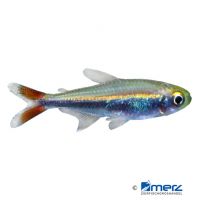Loreto Tetra (Hyphessobrycon loretoensis)
| Loreto Tetra Hyphessobrycon loretoensis | |
|---|---|
| Name | Loreto Tetra |
| Name Lat. | Hyphessobrycon loretoensis |
| Family | Characins |
| Family lat. | Characidae |
| Order | Characins |
| Order lat. | Characiformes |
| Origin | South America |
| Habitat | Forest streams, ponds |
| Diet | Omnivore |
| pH | 5.0-7.0 |
| Behavior | Peaceful |
| Keeping | Group |
| Care Level | Difficult |
| Reproduction | Egg scatterer |
| Breeding | Moderately difficult |
| Life Span | 2-4 years |
| Protection | No |
| Metric Units | |
| Size | 3 cm |
| Temperature | 22-28 °C |
| Hardness | 1-8 °dH |
| Aquarium | 60 cm / 54 l |
| US Units | |
| Size | 1.2" |
| Temperature | 72-82 °F |
| Hardness | 18-142 ppm |
| Aquarium | 15 gal |
Distribution and habitat
Loreto tetras are native to the upper Amazon region of Loreto Province, Peru. They live in slow flowing and stagnant waters, such as small rivers, streams and lakes with dense riparian vegetation and tree roots and branches protruding into the water.
Maintenance
The aquarium should have a varied, partly dense planting, with shelters and hiding places (roots) and provide sufficient swimming space. Soft, slightly acidic water, a dark substrate covered with some foliage (e.g. sea almond leaves), shaded light (floating plants) and a weak current is ideal.
No ammonia, ammonium and nitrite should be detectable, the nitrate value should not exceed 100 mg/l. To ensure the water quality and oxygen content, a filter and heater adapted to the aquarium size is required, as well as lighting for the species-appropriate day-night rhythm of the animals.
Diet
In the wild they feed mainly on small insects and larvae. The diet consists of small live foods such as cyclops, daphnia, artemia and mosquito larvae, which are also well accepted frozen, plus commercially available frozen special food mixtures supplemented with freeze-dried food. High-quality, protein-rich dry food (flakes, granules, micro-pellets) is also accepted without problems.
A regular and varied diet promotes health and increases resistance. Only as much should be fed as is eaten immediately (in a maximum of 10 minutes).
Behaviour and compatibility
They are peaceful and calm schooling fish that can be socialized well with other peaceful, not too lively fish. At least 5, but preferably much more Loertos Tetras should be kept together.
Basically, only compatible fish species with similar demands on water condition and water temperature should be socialized.
Sex dimorphism
The males are more slender than the round-appearing females.
Reproduction and breeding
They are free spawners. In soft, slightly acidic peat water they usually spawn between fine-feathered plants. The larvae hatch after 24-36 hours and swim freely after 2-3 days.
Fry must be fed several times a day with special rearing food (Artemia nauplii). In community tanks breeding is hardly possible, because the spawn is easy prey
Important
Feeding plant foods reduces the risk of fish eating the tender shoots of aquatic plants.
The well-being of the fish should be checked regularly. Temperature should be checked daily, pH, hardness and nitrate levels should be checked at least every 14 days. Regular partial water changes are recommended, even if the contaminant level has not yet reached the upper limit. Sudden changes in water quality should be avoided. Newly introduced fish must be accustomed slowly to the water in the aquarium.
Further literature can be found in your pet store.
References
Text: Werner Winter; Image: Merz Zierfischgroßhandel
Source: BMELV (1998): Tierschutzgutachten - Haltung von Zierfischen (Süßwasser); RIEHL & BAENSCH (2006): Aquarien Atlas Bd. 1, Mergus Verlag; ENGELMANN (2005): Zootierhaltung - Tiere in menschlicher Obhut: Fische, Verlag Harri Deutsch
- Gemäß § 21 Abs. 5 Tierschutzgesetz idgF
